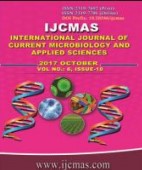


 National Academy of Agricultural Sciences (NAAS)
National Academy of Agricultural Sciences (NAAS)

|
PRINT ISSN : 2319-7692
Online ISSN : 2319-7706 Issues : 12 per year Publisher : Excellent Publishers Email : editorijcmas@gmail.com / submit@ijcmas.com Editor-in-chief: Dr.M.Prakash Index Copernicus ICV 2018: 95.39 NAAS RATING 2020: 5.38 |
In order to develop improved breeding lines having superior yield and oil content, it is essential to have genetically diverse parental lines. Hence, an attempt was made to find out genetic divergence of forty five breeding lines for eleven traits in sunflower. To assess the genetic divergence among the 45 genotypes in sunflower, Mahalanobis D2 statistics was applied for eleven traits. 45 parental genotypes were grouped into six clusters based on D2 values. Among the clusters, cluster I was the largest with 32 parents followed by cluster II with 9 genotypes. Clusters III, IV, V and VI had one genotype each. The maximum diversity was recorded between cluster IV and V (1204.09) followed by cluster VI and V (894.01). Hence parents present in these clusters can be made use in hybridization programme, they might give high heterotic response and wider segregations after hybridization. The study revealed that maximum contribution to divergence was made by plant height, seed yield per plant and oil content. Cluster I composed of restorer genotypes which are having higher mean value for volume weight. RHA-91, which was included in cluster III recorded maximum mean value for oil content. Cluster V (CMS109B) showed maximum mean value for oil yield and seed filling per cent. Based on cluster mean values for a given characters, we can select highly divergent genotypes from the respective clusters and can be used in hybridization work.
 |
 |
 |
 |
 |